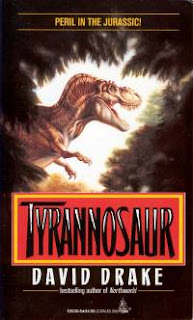 Hardback cover blurb
Hardback cover blurbIt’s the year 1947, and nobody’s interested in dinosaurs anymore. Less than fifty years after Professor Challenger’s famed journey to the Lost World, America’s last dinosaur circus is closing down… but the adventure of a lifetime is about to begin. In a dramatic change of pace, multiple Hugo and Nebula award-winning science fiction master Greg Bear, author of Moving Mars, Anvil of Stars and Queen of Angels, presents a lavishly illustrated thriller that is certain to become a new classic of adventure beyond time…
DINOSAUR SUMMER
Peter Belzoni is dreading summer in Manhattan. Then his father, photojournalist Anthony Belzoni, offers the youth a job, and a byline in National Geographic… and a trip to South America. For Lothar Gluck Circus, once the world’s foremost dinosaur attraction, has gone bankrupt. Left behind is a menagerie of avisaurs, centrosaurs, and ankylosaurs, as well as one predatory raptor named Dagger. And now two filmmakers and the circus trainer plan to return the giants to the wild – with Peter and his dad chronicling the odyssey for Geographic. The task seems impossible. Many have died trying to bring beasts out of the Lost World, the plateau of El Grande in Venezuela, but nobody has ever attempted to transport nearly a dozen full-grown, multi-ton prehistoric creatures across continents, down rivers, through jungles, and up a mountain that has been isolated for 70,000,000 years…
The trek will strain the technologies of trains, cargo ships, barges, trucks… en route lurk robbers and hostile, trigger-happy soldiers… and each miles toward freedom excites Dagger toward an unstoppable, primal killing frenzy. When the unthinkable threatens to strand Peter and the rest of the crew in an uncharted realm, four modern Americans will face all the unknown dangers, mysteries, and terrors of El Grande…
My thoughts
Peter Belzoni gets to live out every boy’s dream: He will accompany his father on an adventure to a remote plateau in Venezuela where dinosaurs still roam. It’s a hell of a way to spend summer break.
It turns out that the Lost World discovered by one Professor Challenger is real. But in the 30 or so years since the discovery, things haven’t gone well. The Lost World was exploited for profit, and many of its animals were captured for zoos and circuses. While the public was at first captivated by the live dinosaurs, it soon lost interest as the fad came and went. King Kong, shot with real dinosaurs, was a box-office flop, and the last dinosaur circus is closing down. The owner of the circus, Lothar Gluck, wants to return his dinosaurs to the Lost World, now a protected sanctuary. Peter and his father will accompany the expedition, but after a bad turn of events, they’ll find themselves stranded in the Lost World, where things far more deadly than dinosaurs roam.
Dinosaur Summer is an unofficial sequel to Sir Arthur Conan Doyle’s The Lost World from Greg Bear, a writer better known for hard sci-fi. It’s a fun read that’s really meant for younger audiences. The illustrations by Tony DiTerlizzi, while excellent, reinforce that fact. The book is a tribute to the filmmakers that Bear grew up with – stop-motion pioneers Ray Harryhousen and Willis O’Brien, and King Kong creators Merian Cooper and Ernest Schoedsack. In fact, all four have major roles in the novel.
A couple critics have complained that Dinosaur Summer was Bear’s overt attempt to write a novel that would be turned into a movie. And yes, it’s true the book was published while Jurassic Park was still all the rage (although, contrary to the cover blurb, the book doesn’t feature a “raptor,” but rather an allosaurus descendant referred to as a “venator”). I think this novel was a labor of love for Bear, an attempt by the author to recapture part of his childhood. It’s light, breezy entertainment and should be accepted as such.
Trivia - Unlike in Doyle’s original novel, there are no ape men or Ice Age mammals roaming Bear’s lost world. However, there are several new creatures not known in the fossil record. Bear imagines a lost world where evolution doesn't stand still, so while there are dinosaurs that have changed very little in 65 million years, there are also animals that have evolved no where else, most noticeably the book’s villain, the Stratoraptor,
- The illustrator, Tony DiTerlizzi, is a well-known children's book illustrator. His web site includes several examples of his work, but nothing from Dinosaur Summer, unfortunately..
- Dinosaur Summer won the first Endeavor Award, a science fiction award for writers from the Pacific Northwest.
Reviews
 Paperback cover blurb
Paperback cover blurb














